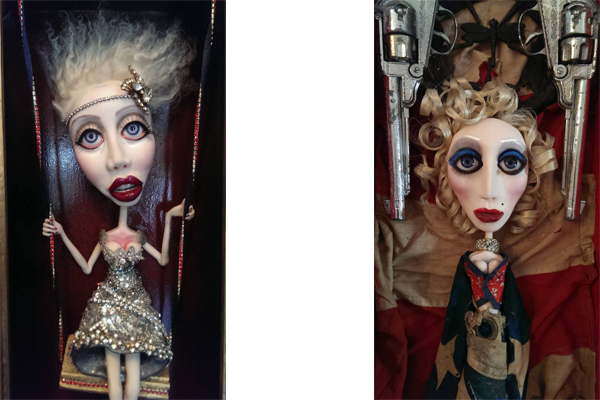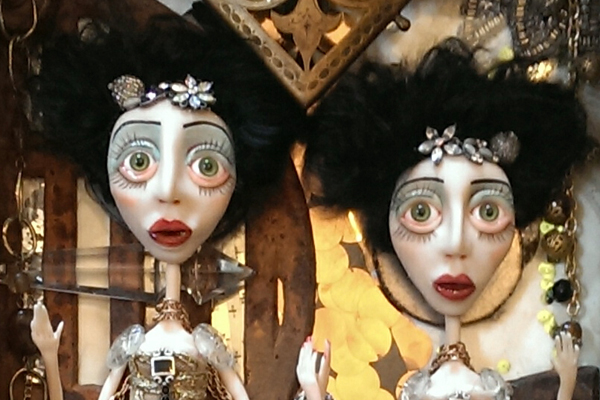Effeminate Ephemera: Vinsantos at Tresor Gallery

Vinsantos, Christina (left) and American Woman (right), both 2014. Mixed media assemblage. Courtesy the artist and Tresor Gallery, New Orleans.
Vinsantos
Tresor Gallery
811 Royal Street
April 24–May 10, 2014
"Effeminate Ephemera" is an exhibition by New Orleans-based conceptual/drag/performance artist Vinsantos, showcasing hand-made wooden boxes containing what the artist terms “Assemblage Art Dolls.” Vinsantos sculpts the faces and limbs of the figures from polymer clay before applying his own makeup and lashes, acrylic paints, and glass eyes. The title of the exhibition alone conjures the image of a delicate deluge of trinkets that have fallen off the vanity and rolled along the baseboard into some mouse hole of a Victorian-era home only to be excavated a century later after that intricate style had fallen, like the trinkets themselves, out of popular fashion.
And indeed much of the ephemera that Vinsantos uses to construct these assemblages are such trinkets: perfume bottles, earrings, shards of crystal, bits of sequined dress. The first piece I encountered was Poe, an ode to the short story writer that needed no title placard. There is the black raven, eyes with lower lids and brows drooping. This Poe frets in a way germane to the author’s stories—around his head is a circle of measurements, a globe of broken ruler fragments, the halo of a brain that is constantly measuring and weighing, heavy with burden. The legs, like the majority of the dolls in this collection, are spindly sticks with feeble yet bulbous feet attached. The knees are bent in the pose of a dash—Poe is running inside a type of cell, perpetually trapped like the terrible master in his own skull.
These wooden boxes can easily be viewed as coffins, outfitted with glass fronts to aid our gaze, disconcertingly tranquil as Sleeping Beauty in the forest. Out of the (un)settled density of New Orleans sediment/sentiment—our own metaphoric forests—these glass-lidded boxes of salvaged materials call to mind the genre to which Poe is inextricably tied—the fairy tale. Much like The Brothers Grimm, there is a staunch macabre air about Vinsantos’s work. A child is withheld a mouth in Bad Nanny, a wolf withheld its arms in Wulf. The heads of these figures are grotesquely large, the waists grotesquely small, and again, we are ushered back to the aesthetic of a previous time and the notion that Victorian constraint can reveal a certain type of Romantic beauty. This work presents a glamorous life-in-death, a macabre masked in mascara. As Keats reminds us when he wrote that melancholy “dwells with Beauty—Beauty that must die; / And Joy, whose hand is ever at his lips / Bidding adieu; aching Pleasure nigh,” the tension between this side of the dirt and the other is always palpable—and permeable.

Vinsantos, Window Shopping (detail), 2014. Mixed media assemblage. Courtesy the artist and Tresor Gallery, New Orleans.
Vinsantos also tells contemporary tales in "Effeminate Ephemera," as a piece titled American Woman features the blue-eyed stare of a doll bracketed by six-shooters, a curly, blond-haired bombshell wrapped in tattered, patinaed stars and stripes. A transformation of Americana bric-a-brac, this piece is America in drag and she’s singing her country’s song, the (broken?) promise of a new life breathed into Old Glory. Window Shopping features two dolls draped in a single boa made of gold chain. Each has a palm lifted and seemingly pressed to the glass. Caught in a web of opulence, their hair is pinned, like their bodies, into place. Their leisure is the source of their mutual bond and they are shackled (both literally and figuratively) to Fifth Avenue, the scripted font of Saks affixed by their feet. Fated to forever look but not touch—a fashionista’s hell—they stand statuesque and tortured as Hans Christian Anderson’s The Girl Who Trod On A Loaf.
Christina is the only doll in the exhibition that has legs to match her body, legs on which the doll could conceivably stand, legs that suggest she might one day be a real girl. She was Vinsantos’s first attempt at sculpting legs from the polymer clay, but they too serve as accessories. Christina is sitting on the bench of a swing, her legs tucked back in the air, calling to mind the curved mermaid tails borne by a few of the other dolls. Like the mermaid’s, her world is not ours; it is decidedly other, her own (little) universe. However, Christina’s wooden box is the only one on display with a functioning door, the only one with hinges that allow the spectator to lift the glass away from the figure, that allow for the possibility of movement, of release. According to Tolkien’s essay on the subject, all good fairy-stories possess “a sudden joyous ‘turn’ (for there is no true end to any fairy-tale),” and Christina is a piece in which the end is still uncertain, in which an outsider (the spectator) can let something in (or out). For Tolkien, the fairy tale should not be a story in which we become lost, a fugitive from our own world, but instead a genre “that for a moment passes outside the frame, rends indeed the very web of the story, and lets a gleam come through,” an artistic medium with the ability to influence and inform our own reality.
If death is an accepted inevitability in Vinsantos’s work, these pieces at least challenge the belief that in death do us part. Our ephemera, effeminate or not, will outlive us—and if our ephemera do not cause joy, exactly, perhaps they can provide consolation. During the wake, the dead still have a role to play. However, when we are laying in the coffin, when we put on our final dress, our final drag, we will not be putting on our own makeup. Our final look is always made, always curated, by another.



